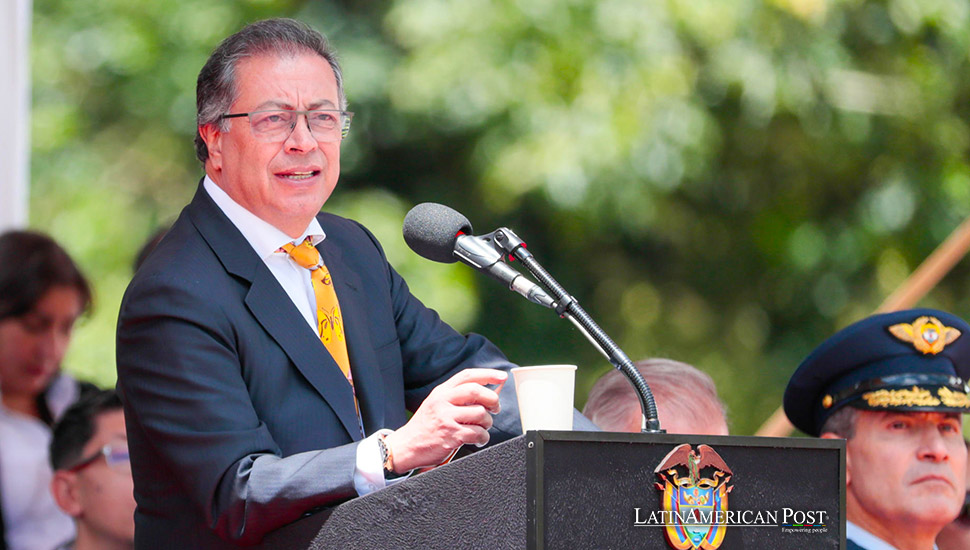Petro’s Colombia Economic Gamble and the Uncertainty of Forced Investments

Colombian President Gustavo Petro’s economic revitalization plan hinges on “forced investments.” However, the ambiguity surrounding this strategy raises questions about its implementation, potential risks, and the future of Colombia’s economic landscape.
Colombian President Gustavo Petro recently unveiled a sweeping economic revitalization plan to transition the country towards clean energy and sustainable development. Central to this plan is “forced investments,” a term that has sparked interest and concern. While the President has positioned these investments as a critical driver of economic transformation, the lack of clarity surrounding their implementation and implications has left many wondering what this strategy entails and how it will affect Colombia’s financial future.
What Are Forced Investments?
During the Economic Reactivation Forum, President Petro introduced the idea of forced investments as a mechanism to redirect public savings into productive economic activities. According to Petro, these investments are intended to stimulate key sectors of the economy, such as renewable energy, agriculture, and infrastructure, which are vital to Colombia’s transition towards a more sustainable and productive economic model.
However, the term “forced investments” remains vague, leaving economists, business leaders, and policymakers grappling with its meaning. Does it imply mandatory contributions from public funds, or does it extend to private sector involvement? Will it require legislative backing, or can it be implemented through executive action? These critical questions remain unanswered, contributing to Petro’s plan’s uncertainty.
On the surface, forced investments align with Petro’s broader goals of economic reactivation and sustainable development. By directing capital into strategic sectors, the government could accelerate growth, create jobs, and reduce the country’s dependence on fossil fuels. For instance, investing in renewable energy could lower production costs and enhance Colombia’s competitiveness on the global stage. At the same time, investments in agriculture could boost food security and reduce poverty in rural areas.
Additionally, forced investments could provide a much-needed boost to Colombia’s banking sector, which Petro noted is currently dealing with deteriorating loan portfolios. By offering new opportunities for profitable investment, forced investments could help stabilize the financial system and support broader economic growth.
The Ambiguity and Risks of Forced Investments
Despite these potential benefits, the ambiguity surrounding forced investments raises significant concerns. One of the primary issues is the lack of clarity about the source of these investments. Petro mentioned redirecting public savings, but what does this mean in practice? Will it involve reallocating funds from existing public programs, increasing taxes, or taking on new debt? Each option carries risks and trade-offs that could impact the economy in unpredictable ways.
Another concern is the potential for forced investments to distort market dynamics. The government could inadvertently create imbalances in the economy by directing capital into specific sectors. For example, prioritizing investments in renewable energy might crowd out funding for other critical areas, such as education or healthcare, which could have long-term social and economic consequences.
Moreover, “forced” implies a degree of compulsion that could raise alarms among investors and the private sector. If the government mandates certain investments or restricts the flow of capital to other areas, it could undermine investor confidence and deter private investment, which is crucial for sustained economic growth. The risk of capital flight, where investors move their money out of the country due to perceived risks, is another potential downside destabilizing the economy.
The implementation of forced investments will likely face significant legislative and legal hurdles. If Petro’s plan requires new laws or amendments to existing ones, it could face resistance in Congress, where the President’s coalition may not have the necessary support to pass such measures. The concept of forced investments could also be challenged in court, mainly if it infringes on property rights or other legal protections.
The recent experience with tax reform provides a cautionary tale. Petro’s initial tax reform proposal, which sought to raise taxes on the oil and coal industries while lowering them for tourism and clean energy, was partially struck down by the Constitutional Court. This setback forced the government to revise its approach and highlighted the difficulties of enacting significant economic changes in a complex legal and political environment.
Comparisons to Historical Precedents
The idea of forced investments is not entirely new, and similar strategies have been employed in other countries with mixed results. For instance, during periods of economic crisis, some governments have mandated the purchase of government bonds or required pension funds to invest in specific sectors. While these measures can temporarily boost the economy, they often come at the cost of reduced investor freedom and long-term financial stability.
In Colombia, forced investments could be seen as a form of state intervention that harks back to earlier periods of economic control. However, the success of such measures depends mainly on how they are implemented and whether they are perceived as fair and effective by the public and the private sector.
Given the uncertainty surrounding forced investments, the Petro administration must provide greater clarity and transparency about its plans. Clear communication is needed to explain how these investments will be financed, managed, and monitored. Additionally, engaging in dialogue with key stakeholders, including the private sector, civil society, and international partners, will build trust and ensure the plan is implemented effectively.
Transparency is also crucial in mitigating the risks associated with forced investments. By providing detailed information about the expected outcomes, potential risks, and safeguards, the government can help reassure investors and the public that the plan is sound and that the benefits will outweigh the costs.
A High-Stakes Gamble
President Gustavo Petro’s economic revitalization plan represents a bold attempt to steer Colombia toward a more sustainable and productive future. However, the ambiguity surrounding the concept of forced investments raises significant questions about how this strategy will be implemented and what its long-term impacts will be.
While forced investments have the potential to drive economic growth and support the transition to a green economy, they also carry substantial risks, particularly if they are perceived as heavy-handed or if they disrupt market dynamics. The success of this approach will depend on the government’s ability to provide clear guidance, build consensus, and navigate the complex legal and political landscape.
Also read: Colombia’s Left Turn: A Decision to Reconsider
As Colombia embarks on this uncertain path, the stakes are high. If managed well, forced investments could help to catalyze the economic transformation that Petro envisions. However, if the risks are not carefully managed, the plan could backfire, leading to unintended consequences that could hamper Colombia’s economic recovery and undermine confidence in the government’s ability to deliver on its promises.





